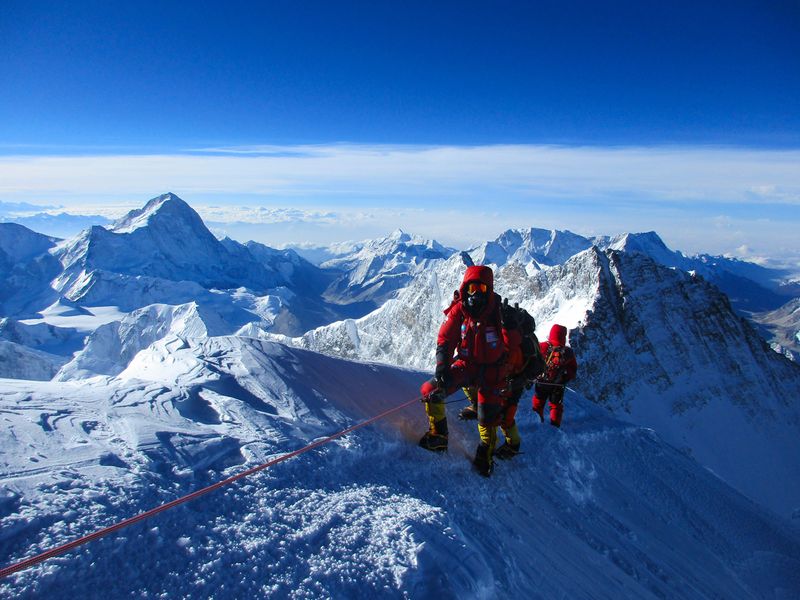THE JOURNAL

Climbing the final steps to the summit of Mount Everest. All photographs courtesy of Mr Garrett Madison
Expert mountain climber Mr Garrett Madison shares his experiences of reaching the top of the highest summit on Earth.
Mr Garrett Madison runs Madison Mountaineering, a boutique mountain guide service that he launched in 2013. He has climbed Everest seven times, guiding more than 44 clients safely to the top — more than any other American in history. Here, he recounts his first attempt.
Everest is the ultimate prize – the closest you can get to space with your feet still on the ground. But when brutal winds and temperatures of -40ºC lash 29,029ft of ice and snow, it is no surprise the lives of nearly 300 people have been lost there since attempts to summit began in the 1920s. I grew up climbing mountains with my father in the US, and from the age of 17, I was hooked. I tried some conventional jobs, but I always found myself back at the mountains. For eight years, I climbed in the Alps and guided expeditions on Mount Rainier, Denali and Aconcagua, but Everest always eluded me – complicated, daunting and incredibly expensive.
And then, in August 2005, I got a phone call from a friend asking me if I would go. There was a private client who wanted the best possible shot of reaching the top, and needed a team of experienced guides to help.
I trained constantly to make sure I was the best asset to the team. I had to source satellite phones, manage blog updates, deliver up-to-date weather reports. Preparations were a lot more complicated back then – now you can even get Wi-Fi on Everest.

Looking out across the high Himalayas from the summit of Mount Everest
In April 2006, we finally arrived at Base Camp – a mash of tents and prayer flags, white peaks in every direction. You can hear the wind whipping and howling down the slopes, and great booms as the ice cracks and falls. The weather dictates when you can climb. A jet stream sits above the summit for most of the year, but every May, it’s pushed off its perch for a precious few moments. That’s the time to strike.
Between Base Camp and Camp 1 you have to traverse the Khumbu Icefall — a dangerous climb across more than 2,000ft of glacier. Everyone wants to get through this section as quickly as possible, but it can take anywhere from three to eight hours, climbing by digging your crampons into the ice walls. At times, huge blocks of ice tumble down, moving like an unstoppable frozen river. On my first Everest attempt, three people died on that glacier. Their bodies, swallowed up by the mountain, were lost forever. It was a sobering moment. I’ve seen much worse happen on Everest since then, but that was the first time I felt truly shocked. Some people decided to turn back. “Is it worth it?” I wondered. But Everest had been a dream of mine for so long. I couldn’t stop.

High Camp on Mount Everest, at the South Col
On 16 May, we reached Camp 2 at 21,300ft, where the clouds roll in from the Lower Himalayan Range. I was feeling ill – a bug I’d probably picked up at Base Camp. I lay awake listening to the mountain murmuring and cracking under my tent, wondering if I’d be able to continue. I struggled on to Camp 3 – a true eagle’s nest perched on the edge of Lhotse Face, an ice wall at 23,500ft – and that night started to feel strong again.
By the time we reached Camp 4 – the “death zone” – the buzz of excitement that had carried us from Base Camp was gone. People were weak, physically exhausted and sheltered in tents, cradling their oxygen tanks. No one really talked. Outside, the landscape was lunar, just ice and black rock. I felt scared as I organised the equipment ready for the final climb.
At 10pm, we headed out. The hours stretched on and on – darkness, wind, heart-stopping moments when the ice cracked or a foot slipped. Then I noticed a thin blue line in the sky, the first sign of dawn. Daylight came very quickly after that, bringing with it the kind of weather you dream about as a mountaineer. It felt like we had the whole mountain to ourselves as we made those final steps.
There’s an energy up there, at the highest point on the planet. It fills you with emotion – joy, awe, heartache, wonder. I broke down in tears. I called my parents from the satellite phone, looking out over the rolling mountains of Tibet and Nepal. Everest felt different to all the other mountains I’d climbed; this time, I was at the top of the world. I don’t know if the next time I climb Everest will be the last, but my first trip taught me to respect the mountain and never give up.
Keep up to date with The Daily by signing up to our weekly email roundup. Click here to update your email preferences.